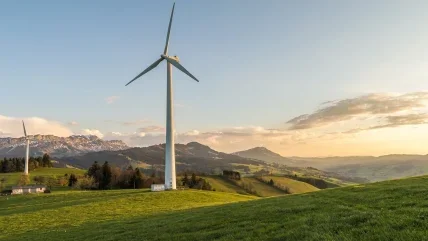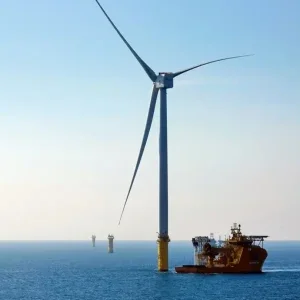
Since 2015, when David Cameron changed the planning laws, England’s onshore wind industry has effectively ground to a halt. Only 17 new onshore wind farms have been approved since then, following what amounted to effectively a ban on new turbines.
This pace of development is glacially slow, especially set against the more ambitious targets that government advisers have been calling for. According to a report by the Institute for Public Policy Research (IPPR), it would take 4,700 years at the present rate for the nation to reach its desired onshore wind capacity. By contrast, had annual build-out rates matched the average pre-ban level, an extra 1.7GW would have been added by 2022. That’s enough to power 1.5 million homes over the winter.
Cameron’s ban, which was controversial even at the time, has remained unpopular among renewable energy advocates, a cross-party group of MPs, and a sizeable proportion of the British public. So, when news broke that Rishi Sunak’s government had finally rescinded the ban, it seemed like there was reason to be hopeful.
“To increase our energy security and develop a cleaner, greener economy, we are introducing new measures to allow local communities to back onshore wind power projects,” said Levelling Up Secretary Michael Gove on 5 September 2023, announcing the decision.
Claire Coutinho, the energy secretary, added that onshore wind had a key role to play in the UK’s energy mix, and that “these changes will help speed up the delivery of projects where local communities want them”. Of course, it should be noted that the ban and its amendment apply to England specifically, and that the planning process has long been more permissive in Scotland and Wales.
Despite the supposed boost to onshore wind, many commentators were quick to remark that the changes don’t go far enough. Shadow Climate Secretary Ed Miliband said the government had “bottled it again”, while Greenpeace UK’s policy director, Doug Parr, claimed “developers will continue to face uncertainty over planning process and be beholden to quixotic decisions by local councils”.
James Robottom, head of onshore wind at RenewableUK, argues that this was less a U-turn and more a “slight softening at the edges”, in actuality. “It’s crazy that it’s easier to build a waste incinerator than an onshore wind farm,” he says. “In terms of what a perfect planning framework would look like, I don’t think we know yet, but we just need onshore wind to be treated like any other technology.”
Going for the small fix
To understand what has changed, we need to go back to 2015 when the moratorium was introduced. Despite pledging to lead the “greenest government ever”, Cameron clamped down hard on onshore wind in his 2015 election manifesto. Claiming that people were “fed up” with “unsightly” wind farms, the then-prime minister ended subsidies to onshore wind – a support measure not reinstated till 2020.
He also added a footnote into the planning guidance that created two new barriers to onshore wind development in England. The first was around planning processes for local authorities. The second stipulated that the impact on local communities needed to be “fully addressed”. In practice, this meant a single objection from a local resident would be enough to stop the project in its tracks.
“The footnote applies to any farm of one turbine or more that’s above 11m, which is tiny,” says Robottom. “Rather than removing the footnote and treating onshore wind like any other infrastructure, Rishi Sunak’s government has kept the two hurdles but lowered them slightly.”
76%
The percentage of the British public that support building renewable energy projects in their local area, according to a 2022 poll.
RenewableUK
The new policy framework does allow for a little more flexibility. There are a few more ways that the local authority can identify areas for development, while a proposed incentive scheme will ensure that local people see the benefits. Meanwhile, individual residents have lost their power to quash a project.
“The wording has changed from an ambiguous ‘fully addressed’ to an equally ambiguous ‘appropriately addressed’,” says Robottom. “That removes one person being able to block it, but it leaves it open to interpretation. Investor interest is still basically zero in England because if you keep those hurdles there it’s risky for developers.”
16%
The percentage of Conservative Party voters, surveyed in 2022 that thought the block on onshore wind should remain.
RenewableUK
Joshua Emden, a senior research fellow at the IPPR, agrees that the reworded footnote is unlikely to be enough to reassure investors. Developers are much more likely to turn to EU countries in which the planning framework is more supportive.
“The wording still requires councils to make a decision one way or another,” he says. “If you are a wind developer, there’s always a risk the council will be able to scupper your project very easily.
Onshore wind is still considered special – the threshold for denying an application is much lower than it is for other technologies.”
The winds of change
From one perspective, the onshore wind ban and its repercussions may seem rather puzzling. Onshore wind is one of the cheapest forms of energy available, and one of the quickest to deploy. As a low-carbon technology, it could play a leading role in England’s journey towards net zero. It could also heighten energy security and cut consumers’ energy bills during a cost-of-living crisis.
Of course, it is not without its detractors. David Cameron was trying to appeal to voters in rural Tory heartlands, many of whom viewed turbines as an eyesore. Onshore projects also tend to attract some pushback from conservationists, who worry about their effects on ecosystems.
However, polling has consistently shown that the UK public are in favour of onshore wind. A 2022 poll from RenewableUK found that 76% support building renewable energy projects in their local area. In that same survey, only 16% of Tory voters said they thought the block on onshore wind should remain. Similarly, a 2021 government study found that 80% of people support onshore wind and only 4% oppose it. Some Conservative MPs, aware of which direction voter sentiment is tracking, have been seeking to revoke the ban since the outset.
1.7GW
The additional wind energy capacity that would have been added in England between 2015–22 if annual build-out rates had matched the pre-ban average.
Institute for Public Policy Research
“There’s a perception that the opposition is greater than it actually is,” says Robottom. “Onshore wind is very popular and I don’t think I’ve spoken to anyone from a younger generation who doesn’t back it.”
When Rishi Sunak became prime minister in October 2022, he indicated he would keep the ban in place. However, a rebellion from his own backbenchers – including former Prime Minister Liz Truss – two months later drove him to soften his stance. He set up a consultation to end the ban, promising that the planning framework would be updated by the end of April. When April came and went and nothing changed, the same group of MPs piled on the pressure.
The amendment was drawn up by Sir Alok Sharma, a Conservative MP and the former president of Cop26, and supported by a group of senior Tories. Unlike the Labour opposition, which has said it would remove all special planning requirements for onshore wind, the Tories have tried to appease those core anti-wind voters.
“I understand that some people would like […] for onshore wind to be treated like any other infrastructure,” said Sharma during a debate on the change to energy legislation on the 5 September. “I get that, but we also have to recognise that it has been a contentious issue in the past, and it is important that we take communities with us on this journey.”
The road ahead
Emden would not dispute that community focus is important. As he points out, people need to feel like projects are happening with their blessing and engagement, rather than off the back of a cursory consultation. “You need to let people know what’s happening and give them opportunities to say where they might want sites to be, so they have a say in the process but don’t disrupt it,” he notes.
He thinks the new guidance might lead to more community energy projects, which don’t need such long pipelines of investment since they’re inherently local. That said, he thinks larger projects will still struggle to get off the ground. “The majority of the onshore wind we’re going to need will come from larger-scale wind farms and investors will probably still be cautious about the prospects,” he concludes.
Robottom maintains that the current planning system isn’t fit for purpose. A better system, he thinks, would ensure developers didn’t have to jump through unnecessary hoops. “There are important things you need to do at the siting of a wind farm, but they have to be proportionate to the scale of development. A single turbine that’s going to help a community power their homes has to be different from a 50-turbine wind farm,” he says.
By November 2023, two months after the rules were eased, England’s stagnant onshore wind market had failed to pick up pace. Not a single new application had been received, which the Guardian described as “a further sign that Rishi Sunak’s antigreen policy shift is driving investment abroad”.
“We aren’t an island when it comes to renewable energy,” points out Robottom. “There are other markets that exist – developers will go to Germany or Scotland, which are backing onshore wind. I’m hopeful things will change, but whether that will happen under the current administration, I’m not sure.”






